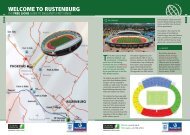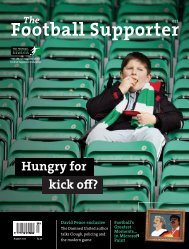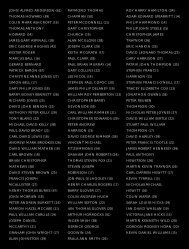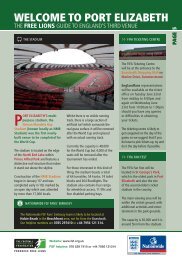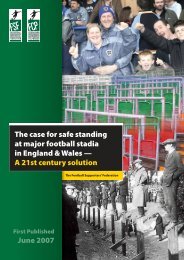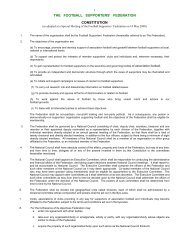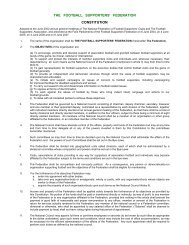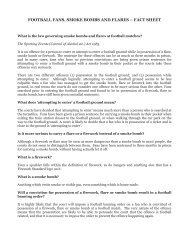Taylor Report - South Yorkshire Police
Taylor Report - South Yorkshire Police
Taylor Report - South Yorkshire Police
Create successful ePaper yourself
Turn your PDF publications into a flip-book with our unique Google optimized e-Paper software.
Headquarters to the Hillsborough police control asking if ambulances were required. This was on the<br />
instruction of Chief Inspector Edmundson who had heard over the radio, as had <strong>Police</strong> Constable Waugh<br />
himself, crowd noise and snatches of speech from Hillsborough suggesting distress and possible injuries. The<br />
reply from the control box was: no reports of injuries but keep standing by. At 3.07 pm after hearing from the<br />
ground that there might be injuries, police Headquarters notified SYMAS that ambulances might be required.<br />
Then, seconds later, Mr Murray's request for a fleet of ambulances was relayed to SYMAS. They reacted at<br />
once. Ambulances began to arrive at the Leppings Lane entrance at 3.13 pm and at the Penistone Road<br />
entrance at 3.17 pm. In all, some 42 ambulances attended, 31 of them from SYMAS and 11 from<br />
neighbouring authorities. By 4.30 pm, they had conveyed some 172 casualties to the Northern General<br />
Hospital and the Royal Hallamshire Hospital.<br />
Gymnasium<br />
107. The gymnasium had been in use for serving meals to the police. When the Major Disaster Plan was<br />
ordered, it was cleared and divided into two. One end became a temporary mortuary; the other was used as a<br />
casualty clearing area for the injured. As the stretchers, designed and improvised, brought in more and more<br />
casualties, the scene was initially and inevitably chaotic and harrowing. There was intense distress amongst<br />
the injured and bereaved; relatives were reluctant to be parted from the dead and sought to revive them. There<br />
were people looking for missing friends and relations; there were recriminations, there were scuffles. Some of<br />
those involved were the worse for drink. Doctors and nurses had followed the casualties in from the pitch and<br />
sought to attend the injured as best they could in the adverse circumstances. Those in most urgent need of<br />
hospital treatment were taken to ambulances as they arrived, triage being employed to determine priorities.<br />
Doctors were requested by the police to examine each person thought to be deceased to confirm and certify<br />
death. A police Constable was detailed to attend and guard each of the dead and a photograph of each was<br />
taken by a police photographer so that relatives coming to identify bodies could be spared the ordeal of<br />
searching amongst all who had died.<br />
The Dead and the Injured<br />
108. Of the 95 who died, the evidence suggests that at least 16 and probably 21 came through gate C after it<br />
opened at 2.52 pm. That is established by the statements of relatives and friends who came through with them<br />
but survived.<br />
109. By commendable hard work, a team of pathologists headed by Professor Usher completed<br />
post-mortem examinations on all the deceased within 48 hours. They found that 88 of the victims were male<br />
and seven female. Thirty-eight were under 20 years of age, 39 were between 20 and 29 years and only three were<br />
over 50. In virtually every case the cause of death was crush asphyxia due to compression of the chest wall<br />
against other bodies or fixed structures so as to prevent inhalation. In all but nine cases that was the sole cause.<br />
In one, pressure on the chest had been so great as to rupture the aorta; in six cases there were also injuries to the<br />
head, neck or chest; in the remaining two cases, natural disease was a contributory factor. In 18 cases bones<br />
were fractured. Thirteen of those were rib fractures. However, one was a fractured femur, one a fractured<br />
radius and the remaining three involved fractures of bones or cartilages round the voice box. These injuries<br />
suggest the victims may have been trodden while on the ground.<br />
110. Blood samples were taken from the dead. No alcohol was found in any of the females. Of the males, 51<br />
had no more than 10 milligrams per cent in their blood which is negligible; 15 had over 80 milligrams per cent<br />
and six over 120 milligrams per cent.<br />
111. Although the great majority of those who died were in pen 3, at least five were in pen 4. Most deaths<br />
occurred at the front of the pens but there were a few fatalities further back.<br />
112. In all, some 730 people complained of being injured inside the ground and 36 outside it. Of the 730,<br />
about 30% are thought to have entered through gate C after 2.52 pm. The largest category of injury was<br />
bruising, especially to the ribs and chest.<br />
18



